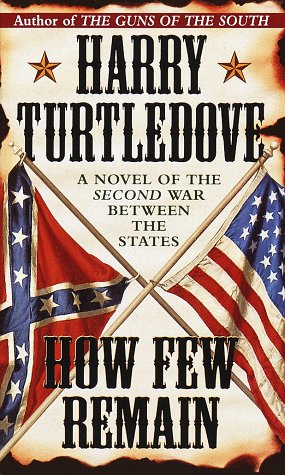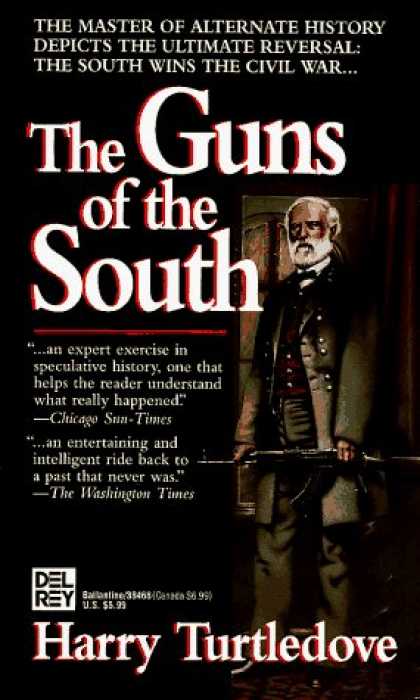Among
his many and varied works, American author, Harry Turtledove has written two
very different novels wherein the Confederate States won the American Civil
war: The
Guns of the South and How Few Remain. One of these novels is very clearly a work of
science fiction; it has the obvious science fiction trope – the time travel
device sending people back in time to change the course of the war by bringing
modern weapons to General Robert E. Lee.
The other novel posits the Confederate victory by more natural means –
the confederate discovery of union battle plans allows General Lee to
decisively defeat the northern army. This
causes a divergence in the time line away from history as we know it, even
without a time machine. They take very different and dissimilar approaches to
changing the events of the past, yet both are works of science fiction (or
speculative fiction, if you prefer.)
The Guns of the South is the obvious work of science fiction. In this novel a group of militants from South Africa travel back to 1864 to deliver AK-47s and other assorted scientific items to Robert E. Lee. Science fiction author often use time travel as a way to alter the world, to explore the world of “what if.” A small change in the past can lead to a radically different today. In this novel a group attempts to create a new world by altering the past. By changing the outcome of the American Civil War they intend to create a world where white men can rule and govern and blacks are still held as slaves.
Introducing this extraordinary change into events of history allows Turtledove to explore the changing ideas and values of the Confederacy. Would a victorious Confederate States of American have continued to keep Africans in slavery?
The
defeated northern states of How Few
Remain harbor resentment and anger toward the Confederate States and not
many years after the Civil War, launch a second war (of Northern Aggression)
desperately trying to reform the union of states – and to exact a measure of
revenge upon the southern rebels. How Few
Remain launched an entire series of novels following this alternate
timeline through what would be contemporaneous with World War I and World War
II in the history that we know and inhabit.
How Few Remain (and the
following books of the series) is less clearly a work of science fiction. It has no time travel and no technology not
existent in the world as we know it. Yet
it also explores the world of “what if” by creating an alternate world, or an
alternate history. What if Abraham
Lincoln had not been shot in Ford’s theater but had gone down in ignominy as
the president who lost the war with the Confederates. What if he had gone on to espouse a decidedly
Marxist sounding idea of labor / capital relations? What would race relations look like in the
Northern states of such an alternate history?
How would international relations have changed?
Orson Scott Card, another popular science fiction author, has written what may be the most expansive and fluid definition of science (or speculative) fiction. “Speculative fiction includes all stories that take place in a setting contrary to known reality.” This definition is broad enough to include Turtledoves, How Few Remain even with its complete lack of all the standard sci-fi tropes. This definition of the genre includes all “stories set in the historical past that contradict know facts of history (Card, 17).
It may not seem very much like science fiction – no rocket-ships, no aliens, gadgets, no time travel. But it very much is a work of science (or speculative) fiction. The story is set in a world that does not. Even so, it is a wonderful “what if” story, and that “what if” is what lies behind great science fiction.
Orson Scott Card, another popular science fiction author, has written what may be the most expansive and fluid definition of science (or speculative) fiction. “Speculative fiction includes all stories that take place in a setting contrary to known reality.” This definition is broad enough to include Turtledoves, How Few Remain even with its complete lack of all the standard sci-fi tropes. This definition of the genre includes all “stories set in the historical past that contradict know facts of history (Card, 17).
It may not seem very much like science fiction – no rocket-ships, no aliens, gadgets, no time travel. But it very much is a work of science (or speculative) fiction. The story is set in a world that does not. Even so, it is a wonderful “what if” story, and that “what if” is what lies behind great science fiction.
The
event that makes the change in the history is somewhat less important than the
consequences. What makes these stories
interesting is the way that new histories and new worlds are formed by the
choices made by the characters within them.
“What Alternative World stories tend to claim, therefore, is that
individual human actions couth; that it is not the vast momentum of world
history that shapes our very lives, but some individual action (Clute, 63).”
We make choices, and those choices have consequences, which lead to more choices and the world changes with everyone.
We make choices, and those choices have consequences, which lead to more choices and the world changes with everyone.
The
alternate world / alternate history branch of the science fiction can use the
standard stereotypical science fiction approaches to creating a new world with
a new history, or it can transform the events of the past without recourse to
science and technology. Both approaches
– as radically different as they are, are both well within the large and
expansive (and fluid, even) boundaries of science (speculative) fiction.
Card,
Orson Scott, How to Write Science Fiction and Fantasy, Writer’s Digest
Books, Cincinnati OH, 1990.
Clute, John, Science Fiction: The Illustrated Encyclopedia, Dorling Kindersly Publishing, Inc., New York, NY, 1995.
Turtledove, Harry, The Guns of the South, Ballentine Books, New York, NY, 1992.
Turtledove, Harry, How Few Remain Ballentine Books, New York NY, 1997.
Clute, John, Science Fiction: The Illustrated Encyclopedia, Dorling Kindersly Publishing, Inc., New York, NY, 1995.
Turtledove, Harry, The Guns of the South, Ballentine Books, New York, NY, 1992.
Turtledove, Harry, How Few Remain Ballentine Books, New York NY, 1997.






No comments:
Post a Comment